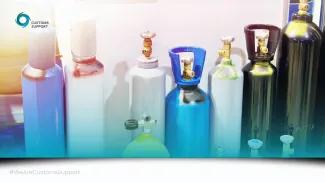Why is there gas in containers?
Containers are often fumigated to combat insects and other pests. Gases most used are phosphine in food products, methyl bromide in wooden products, and ethylene oxide. The last one is used to sterilize medical devices. These gases are intentionally put into the containers.
Another category of gases appears in containers unintentionally. These are dangerous off-gassing gases from products, such as solvents, cleaning agents, and chemicals from glues in packaging materials.
A 6-step plan for safely handling containers
I will take you through a six-step plan that starts with creating procedures to handle potentially dangerous containers. The six steps are:
- Create procedures for handling potentially dangerous containers
- Receiving the containers on location
- Testing the containers
- Taking steps based on test results
- Opening and entering the container
- Create and maintain a database on received containers
Step 1 - Create procedures for handling potentially dangerous containers
Incoming containers can be categorised in three categories:
- The container contains dangerous gasses
- It is unclear if the container contains dangerous gases
- The container is safe to open and Is highly unlikely to contain gases
If you know (or suspect) the container contains dangerous gases, have a gas measurement specialist measure the concentration in the container to determine if it is safe to open and enter the container.
If it is unclear if a container contains dangerous gases, you should follow the same procedure and have a gas measurement specialist determine whether the container is safe to open.
A container is safe to open if these four requirements are met:
- preliminary research shows there are no gasses in the container
- if all containers in the shipment are similar in terms of content
- if measurements of previously received similar containers showed they contained no gasses
- if sample testing has proven that these containers are safe.
Make sure you have procedures for each of these categories of containers arriving at your facility.
Step 2 - Receiving the containers on location
This is the most straightforward step but an important one. When containers arrive at your facility, you have to make sure you correctly identify them and make sure you follow the correct procedure based on whether you know if the containers are safe to open or not.
Step 3 - Testing the containers
Based on what category the container belongs to, it is in this step that you proceed with testing the container.
A licensed gas measurement specialist measures the container and reports his findings. Based on these findings, you take the appropriate steps. The specialist will either conclude that there are dangerous gases and that steps need to be taken before it is safe to open the container or conclude that the container is safe to open.
Always compare the findings of the gas measurement specialists with the outcome of your initial research. When these are not aligned, you may have to update your procedures for similar containers. This is especially important for sample tests of containers that have been designated as safe to open after preliminary research.
Step 4 - Taking steps based on the test results
If the gas measurement specialist has concluded, there are no dangerous gases in the container. You can proceed to the next step and open the container.
If the gas measurement specialist has concluded that there are dangerous gases in the container, you need to take steps to make sure the container is safe to open before doing so. You can degas the container to remove dangerous gases and bring gas concentrations down to a safe level. Make sure the degassing is done with the appropriate equipment and that a properly trained specialist does it.
In some cases, it is impossible to get the gas concentrations down to a safe level, or there may not be enough time to degas the container before unloading it. In that case, the container can be unloaded by trained specialists wearing protective gear.
Step 5 - Opening and entering the container
Before letting anybody open and enter the container, you have to determine if the container is safe. A container is safe to open if the gas measurement specialist has determined that it is safe to open, whether it is a category A or a category B container or a category C container that was checked as a sample test. Category C containers require only sample checks and do not have to be measured every time. Based on the test results and the gas measurement expert’s recommendations, you have to make sure that persons opening and entering the container take preventive measures. These may include wearing protective gear.
Persons entering a container should always leave the container immediately when they suspect that there are dangerous gases despite all steps being taken to prevent that. The container should be sealed and marked, so nobody opens or enters the container before determining that it is safe to enter.
Step 6 - Create and maintain a database on received containers
Make sure you collect and save all the data around incoming containers. Doing so will enable you to categorize containers with better accuracy and prevent future incidents. The database should contain information like where the container was coming from, what the contents were, what the gas measurement results were, and what measures were taken to make the container safe to open.
Being Safe is Being Sure. Ask an Expert.
If you have any questions about gas-related matters or need support with fumigation or degassing of your shipment, a risk analysis, or any other gas-related issue, please contact one of our trained and experienced specialists. They are happy to help. Customs Support: Take the load off your mind!












